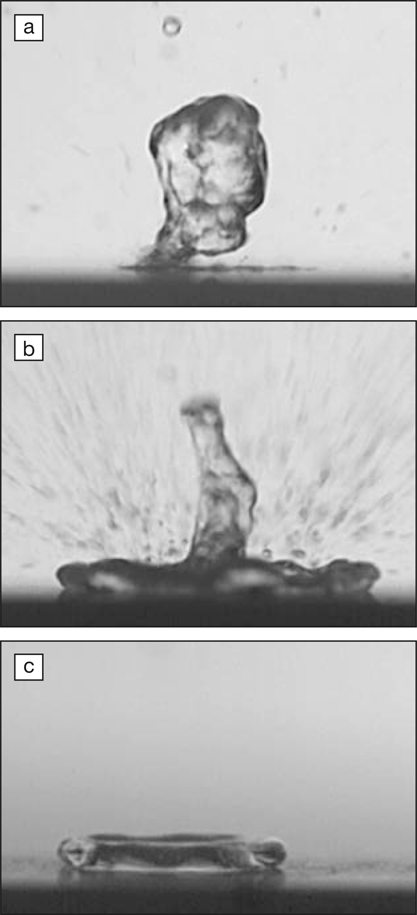Ceramics are typically used for applications demanding mechanical and chemical protection. However, the insulating properties of ceramics usually make them unsuitable for applications in which resistance to thermal shock is required. When a cold liquid touches a hot surface—as occurs on many occasions such as in wind turbines, steam engines, or even in the bakery when making a crispy crust on bread—convective heat transfer generates thermal stresses at the surface of the material. When a ceramic is involved, it usually cracks.
In a recent study published in AIP Advances (doi:10.1063/1.5041809), Divya Prakash and Youho Lee from The University of New Mexico, Albuquerque, explore surface heat-transfer of an aluminum oxide (alumina) ceramic—one of the most widely used ceramics—and propose a simple strategy to protect it from thermal fatigue-induced failure.
The researchers impacted a heated alumina surface with a cold water drop and recorded its heat-transfer modes at the surface, including a “tornado lift-off” (see Fig. a) and a water jet (Fig. b).
Since cracks are the hallmark of thermal shock, measurement of the residual strength of the material provides information about its ability to withstand sharp variations in temperature. The alumina coupons used in the study could withstand a sudden temperature gradient from 25°C to 325°C, but the strength decreased above 200°C. By relating these measurements to the surface heat flux, the researchers suggested that a hydrophobic surface containing air pockets would protect the ceramic. Upon implementing this approach by coating the alumina substrate with a porous silica layer to give rise to a contact angle of 145°, typical of hydrophobicity, the incoming cold water was found to form a planar film at the surface (see Fig. c) and the residual strength remained high up to 350°C.
These results suggest a new coating-based approach to afford thermal-shock protection to ceramics, which Lee plans to develop in the future “to enhance our current mechanistic understanding and increase the temperature range.” He also emphasizes that “the surface nanostructure plays a dominant role in the rate of boiling surface heat transfer, so a hydrophobic polymer can work in similar ways.” Indeed, the calculated predictions take into account the contact area between the incoming water and the surface, which is drastically reduced on hydrophobic surfaces. This strategy therefore opens up new avenues for resistance to thermal shocks in a wide range of applications.

(a) Tornado lift-off of cold water impacting a ceramic heated to 175°C and (b) water jet occurring on the same surface heated to 300°C. (c) Appearance of the droplet after applying the hydrophobic coating to the alumina ceramic. Credit: AIP Advances.
Carolina Tallon, assistant professor at Virginia Tech, who is unaffiliated with the study, finds this work very exciting. Her group develops ultrahigh-temperature ceramics components for extreme applications such as hypersonic vehicles. “The idea of controlling the nanostructure at the surface of the material to increase the thermal-shock resistance—but also to be able to correlate the surface heat transfer experienced by the material to detect the actual thermal stress it was submitted to—will have a significant impact in the high-temperature materials community. For example, it can be used to test, evaluate, and predict the response of the ceramics in stringent conditions, where direct experimental measurements are not always feasible.” Tallon cautions, though, that “in the case of extreme thermal loads as the ones experienced in hypersonic conditions, the challenge of developing a substrate that has a suitable temperature resistance, thermal expansion coefficient, and thermal conductivity still remains.”


